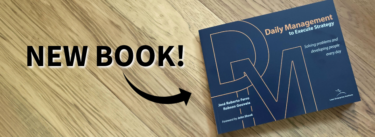Dear Gemba Coach,
I have just finished reading The Lean Manager, and I was very taken by the chapter on teamwork. I am a lean officer in a bank and have been working with back-office processes for the past two years. We have had good successes on the sites, but the general feeling is that lean has increased conflict with other departments. Have you any advice on how to address this?
Great question, although I’m not sure this Gemba coach is the best placed person in the world to give relationship advice! As always, let’s frame the question by doing what we always do as a first step: go to the gemba. Let’s observe the work as a way to see how (and why) lean can increase internal conflict rather than generate teamwork. You are not the only person, by the way, who faces this challenge. Virtually everyone tackling lean in earnest discovers increased conflict, even in the midst of real progress!
In order to visualize back office processes in your bank I’ll draw from an office I am familiar with. You have employees working in a open plan area. Each has a clear job such as transcribing forms (such as funds transfer) into the computer, and clearing the transaction. Doing lean in such a work environment focuses on 1) figuring out and sorting out the flow of work through the office and 2) solving all causes of variation that affect operators in order to increase the number of “right first time” operations, which can dramatically affect productivity.
The primary interruptions of flow and sources of variation in these settings stem from internal causes: the printer doesn’t work, or never has the right cartridge, colleagues must work with unclear of incomplete customer forms, or (deep breath) the information technology does not work the way it should – though let’s not get started on software problems. Problems increase when dealing with other departments, which have not been involved with the lean programs. Workers in these departments won’t prioritize a flurry of requests that may matter for your lean efforts yet whose purpose is not clear to them. And then, when these problems are not addressed, e-mails become insistent, arguments go up the food chain, and the previously polite relationship deteriorates. We feel that on top of being generally incompetent they have become sullen and resentful, and so are not able to 1) affect the least little change to what they do 2) get it right when we finally get them to do something. And they, on the other hand, come to believe that these lean zealots are getting self-important, are constantly making unreasonable requests, and have no idea of how much work pressure we’re already under. Any natural common ground dissolves. Once the “lean” side made the assessment that the others are basically incompetent, and the receiving end thinks that the “lean” guys are unreasonable and unbearably arrogant, it’s indeed difficult to de-escalate and repair the relationship. Everyone is the hero of their own movie.
So what’s going on here? To start with, let’s have a theory. Every work situation has two basic components: the deal (the work exchange) and the relationship (attitudes such as good will or annoyance towards co-workers). These two dimensions are intimately linked. Any change in the deal will affect the relationship. Conversely, the nature of the relationship will often make or break deals. How will lean impact this? First, the deal.
As Steven Spear has shown, lean work has the effect of clarifying and specifying:
- System: what does the organization produce and deliver (mix, volume, timing) for whom?
- Pathway: who creates what output (product, service, or information) for whom?
- Connection: how do customers and suppliers communicate requests and responses?
- Activities: how do people or machines produce or deliver outputs for which they are responsible given the connections they have with immediate customers and suppliers.
In practice, not only is work more specified, but problems are highlighted, which causes pressure to treat them now! This becomes a fundamentally new sort of challenge when these problems involve other departments. Whereas before, the interaction was an “over the wall” exchange where other folks could do this job whenever they got to it, moving to a pull system forces things to get done right away (because if not we won’t be able to deliver to our customers), and getting done right the first time (because if not we will have to waste a lot of time with back-and-forths and not be doing something else instead). Furthermore, priorities change radically: now, small things must be straightened out right away, and worry about the big reorganizations can be dealt with later. This is fundamental change in the way most organizations work.
How does that affect the relationship? Just as lean exposes waste in processes, it also surfaces conflicts. Previously, the relationship within the value chain was well buffered with walls and stocks or waiting queues. Folks dealt with each other on a mostly social basis. You’re polite with each other, and chummy up at the canteen with the people you like, largely ignoring those you don’t. It’s essentially a pact of non-agression: you have no say in the way I work, so I won’t either and every one tries to get along.
Kaizen typically will challenge this status quo. By focusing on internal customer-supplier relationship, suddenly, all our actions are linked. We all have something to say about how our colleagues work inasmuch as it affects our own delivery. Lean practice requires every individual everywhere to develop common ownership of problems. How to do this if they won’t play ball? And to be fair, why should they when you’ve suddenly and brutally destroyed a departmental truce that has been in place since the beginning of time? Unfortunately, most initial efforts to “make things work” only worsens the situation. Frustrated with the lack of progress, the lean coach pulls the only lever he has by going up the food chain to complain about lack of cooperation. Senior managers react as senior managers do, they give a stern talking to their subordinates, which reinforces the hard done by feeling of its not fair.
So how could be possibly try to address this? There are no hard and fast answers. First, let’s apply lean thinking to ourselves. What would be the test criteria for a “good working relationship”? Again, there is no particular lean dogma on the subject. Here are the four criteria I use as a rule of thumb to evaluate working relationships:
- Accuracy: in production this means sending good parts on time. How does this translate to information flows? Essentially this means that you exchange the information needed to move your own work one step further. It turns out that many work exchanges are very vague about what this means. Even when you get specific numbers out of your colleagues, unless they’ve understood what you want to do (what’s your purpose), the way the information is cherry-picked or formatted will not help you, and cause a flurry of e-mail exchanges to get to the right format.
- Availability: in his early stand-up days, Woody Allen described a dog-eat-dog world as “dog doesn’t answer phone calls” world. It’s gotten significantly worse now that you have e-mail. We expect all our colleagues to be immediately available and to answer that e-mail in the hour, or in the day. Longer than that and we feel that the message is clear: you’re less important than others to whom I am answering to quickly. The leaner you get, the greater the importance of speed of response. Of course, quick answers are easier if there is a system in place to generate the answer, and, in time the system itself can eliminate the need for the exchange. But availability has to be recognized as a genuine concern by both parties in the relationship. Start by establishing a standard response time to avoid unnecessary annoyance.
- Attitude: the basic attitude of lean is “problems first”: every concern, from everyone, is legitimate and we’ll take it seriously. This doesn’t mean immediately resolving the problem, but it does mean immediately looking into it and doing what can be done. Not out of moral grandeur, but because this is the essential oil that makes processes work across functional barriers. No one is going to argue against a “positive” attitude, but across departments, it’s easy to consider that the colleagues on the other side of the wall should take care of their own affairs and are not legitimate in addressing problems in our area. Once attitudes start off on the wrong foot, it’s hard to recapture, as resentment build resentment and so on.
- Advice: indeed, that’s the clincher of any good working relationship. Work productivity increases tenfold when people accept advice across functional boundaries, and when this advice is sensible. One the biggest problems about individuals who are not are not very good at what they do (often because they’re in a poorly managed environment) is that they are also very rigid about listening to other points of view (reminding one of another joke quoted by Woody Allen, about the food at a Catskills resort: terrible food—and such small portions too!). It’s important to recognize how challenged individuals feel when approached about their work, and how powerless they often feel about making change. Confronting experiences and points of view, particularly on your own work, is an essential source of progress – and core to lean learning (hence the emphasis on teamwork).
This four A approach to specifying the relationship isn’t specifically “lean” and few people would argue against them being a good thing in any work relationship. The power of specifying the relationship in these terms is that now some relational issues are actionable. To being with, you, as a lean coach, can start assessing how you fare on these four criteria. It takes two to tango, and the start of addressing the problem is taking responsibility for your part of the problem.
Having done the exercises on yourself and having gained a deeper understanding of what these criteria mean in your own work environment, it’s time to bite the bullet and go to the boss with this. The idea here is not to get any department to do anything, but to get the four As accepted as valid criteria for working across functional department in the organization. If this gets okay-ed, as a lean coach, it’s legitimate to come up with a self-assessment for each department to do on how they see their relationships with other services on the basis of these criteria.
And then hope for the best.
As Chris Argyris has shown, deep problems in organizations can remain unaddressed for so long that they ultimately lead a company to disaster. That’s because they become taboo subjects to discuss at first; and then, over time, the fact that they have become taboo becomes taboo as well. They grow into undiscuss-able problems, which, because they cannot even be framed productively, can not be dealt with. Many cultural and historical and political factors contribute to this. What’s important here is recognizing this dynamic and finding ways to expose problems and use lean practice to tee them up in a way that they can be addressed.
The long and short of it is that in applying lean thinking to the relationship part of work we should 1) treat all relationships as if they were long term and 2) specify the nature of the relationship in greater detail, just as we’ve specified the work element and the triggers to move work from one step to the next.
A the end of the day, the way to improve relationships, as with everything else in lean – starts with knowing enough about relationships to be able to build a PDCA cycle on the problem. The 4 As are a good place to start to build a check, but only the starting place. Every situation is different, and every person is different, so each action plan has to be individualized – but usually people prefer getting along to adversarial, so there is hope!






